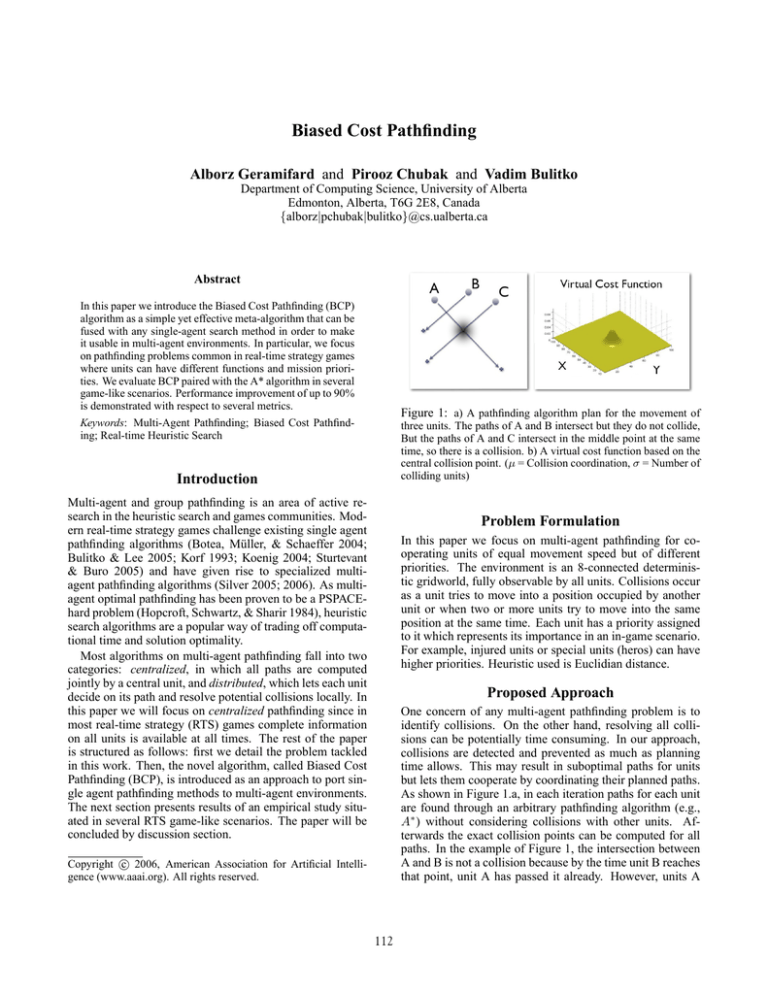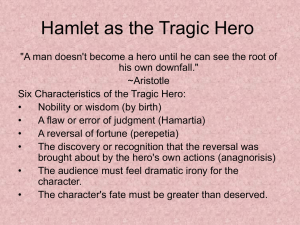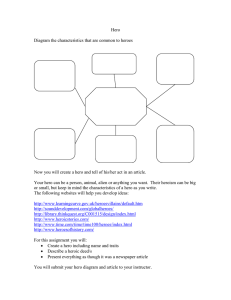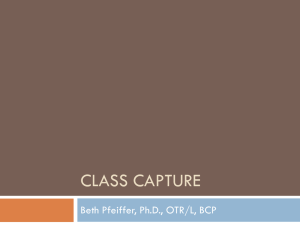
Biased Cost Pathfinding
Alborz Geramifard and Pirooz Chubak and Vadim Bulitko
Department of Computing Science, University of Alberta
Edmonton, Alberta, T6G 2E8, Canada
{alborz|pchubak|bulitko}@cs.ualberta.ca
Abstract
In this paper we introduce the Biased Cost Pathfinding (BCP)
algorithm as a simple yet effective meta-algorithm that can be
fused with any single-agent search method in order to make
it usable in multi-agent environments. In particular, we focus
on pathfinding problems common in real-time strategy games
where units can have different functions and mission priorities. We evaluate BCP paired with the A* algorithm in several
game-like scenarios. Performance improvement of up to 90%
is demonstrated with respect to several metrics.
Figure 1: a) A pathfinding algorithm plan for the movement of
Keywords: Multi-Agent Pathfinding; Biased Cost Pathfinding; Real-time Heuristic Search
three units. The paths of A and B intersect but they do not collide,
But the paths of A and C intersect in the middle point at the same
time, so there is a collision. b) A virtual cost function based on the
central collision point. (µ = Collision coordination, σ = Number of
colliding units)
Introduction
Multi-agent and group pathfinding is an area of active research in the heuristic search and games communities. Modern real-time strategy games challenge existing single agent
pathfinding algorithms (Botea, Müller, & Schaeffer 2004;
Bulitko & Lee 2005; Korf 1993; Koenig 2004; Sturtevant
& Buro 2005) and have given rise to specialized multiagent pathfinding algorithms (Silver 2005; 2006). As multiagent optimal pathfinding has been proven to be a PSPACEhard problem (Hopcroft, Schwartz, & Sharir 1984), heuristic
search algorithms are a popular way of trading off computational time and solution optimality.
Most algorithms on multi-agent pathfinding fall into two
categories: centralized, in which all paths are computed
jointly by a central unit, and distributed, which lets each unit
decide on its path and resolve potential collisions locally. In
this paper we will focus on centralized pathfinding since in
most real-time strategy (RTS) games complete information
on all units is available at all times. The rest of the paper
is structured as follows: first we detail the problem tackled
in this work. Then, the novel algorithm, called Biased Cost
Pathfinding (BCP), is introduced as an approach to port single agent pathfinding methods to multi-agent environments.
The next section presents results of an empirical study situated in several RTS game-like scenarios. The paper will be
concluded by discussion section.
Problem Formulation
In this paper we focus on multi-agent pathfinding for cooperating units of equal movement speed but of different
priorities. The environment is an 8-connected deterministic gridworld, fully observable by all units. Collisions occur
as a unit tries to move into a position occupied by another
unit or when two or more units try to move into the same
position at the same time. Each unit has a priority assigned
to it which represents its importance in an in-game scenario.
For example, injured units or special units (heros) can have
higher priorities. Heuristic used is Euclidian distance.
Proposed Approach
One concern of any multi-agent pathfinding problem is to
identify collisions. On the other hand, resolving all collisions can be potentially time consuming. In our approach,
collisions are detected and prevented as much as planning
time allows. This may result in suboptimal paths for units
but lets them cooperate by coordinating their planned paths.
As shown in Figure 1.a, in each iteration paths for each unit
are found through an arbitrary pathfinding algorithm (e.g.,
A∗ ) without considering collisions with other units. Afterwards the exact collision points can be computed for all
paths. In the example of Figure 1, the intersection between
A and B is not a collision because by the time unit B reaches
that point, unit A has passed it already. However, units A
c 2006, American Association for Artificial IntelliCopyright gence (www.aaai.org). All rights reserved.
112
and C will collide at the center point. In order to resolve
collisions, a biased cost function1 is defined on such points
for all of the colliding units except the unit with the highest
priority. This encourages all colliding units to replan their
paths except the one which will be given the highest priority.
Assuming unit C has the highest priority, Figure 1.b shows a
Gaussian function centered on the collision point which will
cause unit A to replan its path. After one iteration the set
of virtual cost functions for each agent will be updated. By
adding these functions to the actual heuristic values, the path
finding algorithm will find new paths for each unit. This will
decrease the probability of having the same collisions on the
next pathfinding trial. This process can be done iteratively
until the time limit is reached or no more collisions are detected.
The BCP algorithm is shown in Figure 2. On line 3, for
each unit a limited path considering the virtual heuristic values (h0 ) from previous iterations is planned. The information
on the paths is inserted into a hash table called CollisionDetector. After finishing the planning, all collisions are computed from the hash table. Each collision is defined by its
position (x, y) and the set of units colliding in it. On line
12, the unit with the highest priority is omitted from the list.
This allows that specific unit to occupy the position on the
next iteration and discourage the rest of the colliding units
from getting close to that collision point. Each agent maintains its own set of virtual cost functions. In line 14, the new
virtual heuristic is added to the rest of the colliding units.
This virtual cost is modeled as a Gaussian function with the
mean at the collision location and the variance relative to
the number of colliding units. On the next iteration the new
paths are generated taking all virtual cost functions into account. The result returned in line 23 is the set of paths for all
units with the least number of collisions that has been found
so far. h0 is being computed for any given position and unit
by extracting the list of virtual cost functions assigned to that
unit. Then all of the virtual functions are computed for the
given position and summed up.
We expect BCP to help units (especially prioritized ones)
reach their goals faster compared to original single agent
pathfinding method. On the other hand BCP has a higher
computational complexity due to repeated planning trials
and heuristic refinement.
BCP
0 Colliding ← True
1 While time is available and Colliding do
2
For each unit i on the map do
3
p ← Limited path from the start to the goal of unit i
with maximum length k considering heuristic as h + h0
4
reset the time: t ← 0
5
For each position n on path p do
6
CollisionDetector.add(n, t, i)
7
end for
8
end for
9
C ← CollisionDetector.getCollisions()
10
For each collision c in C do
11
A ← c.units()
12
Delete the unit with highest priority from A
13
For each unit i in A do
14
VirtualHeuristic.add(i, c.x, c.y, c.size)
15
end for
16
end for
18
if C is not empty
19
Colliding ← True
20
else
21
Colliding ← False
22 end while
23 return set of paths with least number of collisions
Figure 2: Pseudo-code for BCP algorithm
Figure 3: A sample configuation of units for Rescue the Hero
scenario.
Rescue the Hero
For the first set of experiments we simulated a scenario commonly found in most RTS games. Suppose a high priority unit (called hero hereafter) is badly injured and the user
wants to return it to the base while enemy units are attacking it. The user also sends a group of units to defend the
hero and stop the enemies. Unfortunately, the hero collides
with its friendly units and while struggling to find a new
path, is eliminated by the attackers. Figure 3 shows this scenario in simulation. The unit on the left side (hero) wants to
reach a location on the right side, while support units want
to come left in order to secure the hero. In our experiments
the hero had difficulties passing through the support units
using A∗ method. Also, support units lacked a good cooperation between themselves. However, the BCP agents
anticipated forthcoming collisions with the hero and started
to drift away from their straight path in the middle. As the
middle units planed to shift to the bottom, the bottom most
units cooperated with them and started their shift to the bottom. When the hero passed the group, they moved close and
reached their goals.
In Figure 4 the results of A* and BCP algorithms are
Empirical Evaluation
We situated our empirical evaluation in a recent RTS gamelike open source testbed (Sturtevant 2005). It allowed us to
set up controlled experiments based on scenarios from commercial games. We picked A∗ as the basic pathfinding algorithm as it is commonly used in commercial games. The
small scale of these scenarios enabled complete path computation. In order to increase the speed of the algorithm,
the effective areas of the Gaussian functions are limited to
2σ and if one collision is detected the rest of the path is ignored. All tests have been done on a computer with an Intel
P4 3.0 GHz CPU and 512 MB of RAM.
1
This function will be used later in order to compute virtual
heuristic values (h0 ).
113
the death rate of the hero averaged over 18 runs with random
starting positions of the hero in a 3 × 7 rectangle. In order to
make the random tests interesting, we set the HP of the hero
to the mean of all damages it took on all iterations of BCP.
As Figure 5 depicts, by increasing the number of iterations
the death rate of the hero decreases in all cases.
Discussion
In small-scale scenarios inspired by common situations in
real-time strategy games, BCP improved A∗ results for cooperative multi-agent pathfinding. Specifically, the hero unit
was able to leave enemy territory without colliding with ally
units. Consequently, the damage it incurred during the evacuation sequence was minimized and in the last test case the
death rate has been reduced by 90%. On the down side,
BCP adds overhead to the A∗ computation. While scaleup experiments are in progress to establish its limits, one
can speed up BCP by capping the number of iterations (m)
appropriately. This allows a game AI designer to trade off
pathfinding performance for computational efficiency.
Figure 4: The comparission of A∗ and BCP heros in terms of total
number of steps taken by each of them to get their goal in scenario
one. Results averaged over 10 experiments.
Acknowledgments
We greatly appreciate the insightful comments of David Silver, Nathan Sturtevant and Anna Koop.
References
Botea, A.; Müller, M.; and Schaeffer, J. 2004. Near optimal hierarchical path-finding. In Journal of Game Development, volume 1, 7–28.
Bulitko, V., and Lee, G. 2005. Learning in real time search:
A unifying framework. Journal of Artificial Intelligence
Research, Volume 24.
Hopcroft, J. E.; Schwartz, J. T.; and Sharir, M. 1984.
On the complexity of motion planning for multiple independent objects: Pspace-hardness for the warehousman’s
problem. In International Journal of Robotics Research,
volume 3, 76–88.
Koenig, S. 2004. A comparison of fast search methods for
real-time situated agents. In Proceedings of the International Joint Conference on Autonomous Agents and Multiagent Systems (AAMAS), 864–871.
Korf, R. E. 1993. Real time heuristic search. In Artificial
Intelligence, volume 27, 97–109.
Silver, D. 2005. Cooperative pathfinding. In Proceedings
of the 1st Conference on Artificial Intelligence and Interactive Digital Entertainment.
Silver, D. 2006. Cooperative path-planning. In AI Programming Wisdom.
Sturtevant, N., and Buro, M. 2005. Partial pathfinding
using map abstraction and refinement. In AAAI, Pittsburgh.
Sturtevant, N. 2005. Hierarchical open graph. In
http://www.cs.ualberta.ca/ nathanst/hog/.
Figure 5: Death rate of the hero in three extensions of scenario
one based on the number of iterations averaged over 18 samples.
shown for the aforementioned scenario with different numbers of support units positioned randomly in a 3 × 3 matrix
at the right side. Each graph shows the time steps needed
for the hero unit to reach its goal, averaged over 10 samples. The BCP hero could reach its target in 10 time steps in
all cases. This means that all of the other units considered
its priority and avoided any kind of collision with the hero
while reaching their goal. On the other hand, the A∗ hero
almost always collided with other units and failed to reach
its goal in 10 time steps. In all cases the required time for
BCP method did not exceed half a second.
Rescue the hero: Extensions
In order to show the effectiveness of BCP in practical environments, the previous scenario has been extended into
three different sub-scenarios. In the first one, the hero is
fleeing from a critical situation with a low hit-point (HP)
count while being chased by a ranged attacker. On each cycle if the hero is in the attacker’s range it will lose one HP.
If the hero stands still, an additional HP is deducted. For the
next two extensions we put respectively one and two static
attackers which would decrease the HP of the hero by one
on each cycle if the hero is in their range. Figure 5 shows
the result of all extensions. The horizontal axis illustrates the
number of iterations used for BCP. Note that the first number
represents the initial A∗ algorithm. The vertical axis shows
114




